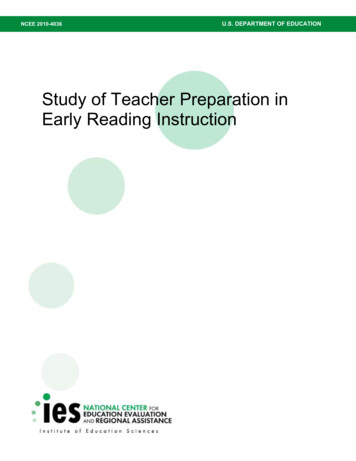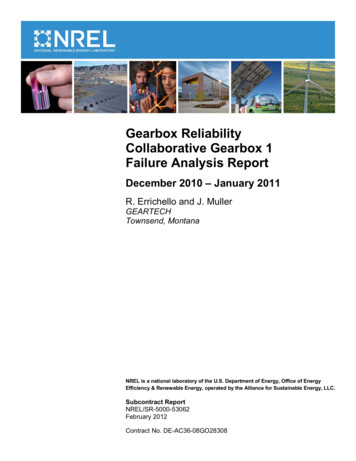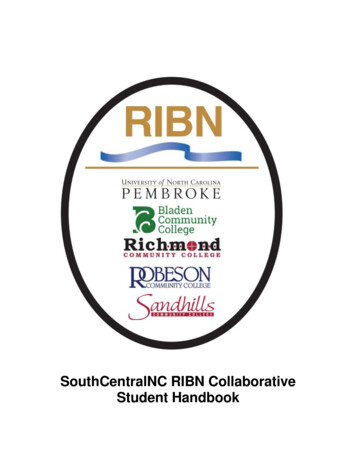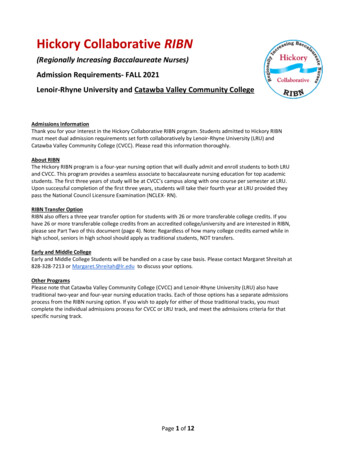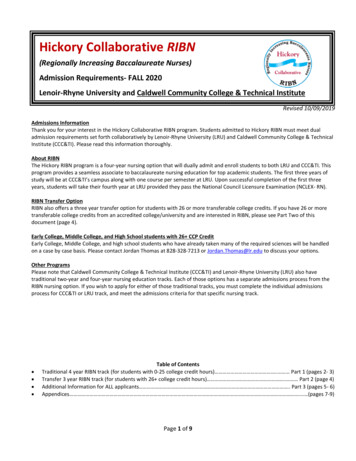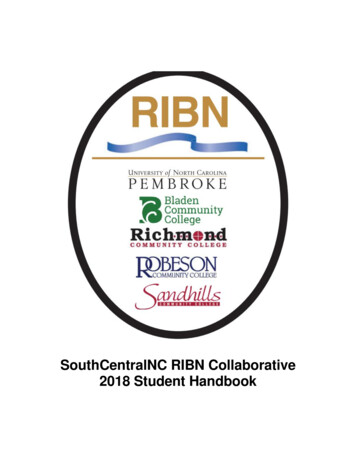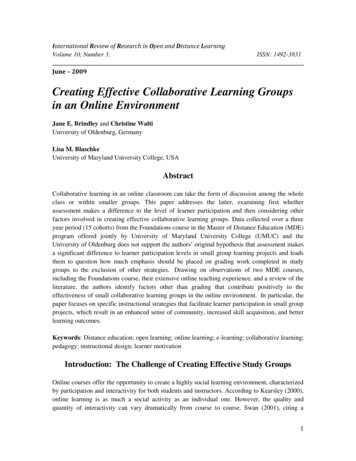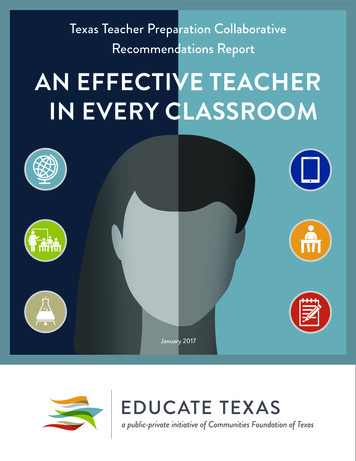
Transcription
Texas Teacher Preparation CollaborativeRecommendations ReportAN EFFECTIVE TEACHERIN EVERY CLASSROOMJanuary 2017
TABLE OF CONTENTSLetter from Collaborative Chairman Nelson and Vice Chairman Chard . . . . . . . . . . . . . . . . . . . . . . . . . . iiIntroduction. . . . . . . . . . . . . . . . . . . . . . . . . . . . . . . . . . . . . . . . . . . . . . . . . . . . . . . . . . . . . . . . . . . . . . . . . . . . . 1Collaborative Process and Organization of the Report. . . . . . . . . . . . . . . . . . . . . . . . . . . . . . . . . . . . . . . . . 4Recommendation Summary. . . . . . . . . . . . . . . . . . . . . . . . . . . . . . . . . . . . . . . . . . . . . . . . . . . . . . . . . . . . . . . 4Recommendation 1: Establish a competency-based, tiered licensure systemthat differentiates performance and strengthens teaching as a profession. . . . . . . . . . . . . . . . . . . . . . . . 5Proposed Licensure Model. . . . . . . . . . . . . . . . . . . . . . . . . . . . . . . . . . . . . . . . . . . . . . . . . . . . . . . . . . . . . . . . 6Recommendation 1 Rationale. . . . . . . . . . . . . . . . . . . . . . . . . . . . . . . . . . . . . . . . . . . . . . . . . . . . . . . . . . . . . . 9Tiered Licensure. . . . . . . . . . . . . . . . . . . . . . . . . . . . . . . . . . . . . . . . . . . . . . . . . . . . . . . . . . . . . . . . . . . . . . . . . . . . . . . . . . . . . . . 10Collaboration and Support for New Teachers . . . . . . . . . . . . . . . . . . . . . . . . . . . . . . . . . . . . . . . . . . . . . . . . . . . . . . . . . . . . . . 12Reciprocity to Increase Capable and Effective Teachers. . . . . . . . . . . . . . . . . . . . . . . . . . . . . . . . . . . . . . . . . . . . . . . . . . . . . . 13Recommendation 2: Enhance the Texas Educator Preparation Program evaluation systemto increase accountability, drive program outcome improvement, and provide publictransparency on program performance. . . . . . . . . . . . . . . . . . . . . . . . . . . . . . . . . . . . . . . . . . . . . . . . . . 14Recommendation 2 Rationale. . . . . . . . . . . . . . . . . . . . . . . . . . . . . . . . . . . . . . . . . . . . . . . . . . . . . . . . . . . . . 14Accreditation . . . . . . . . . . . . . . . . . . . . . . . . . . . . . . . . . . . . . . . . . . . . . . . . . . . . . . . . . . . . . . . . . . . . . . . . . . . . . . . . . . . . . . . . . 15State System for EPP Performance and Accountability . . . . . . . . . . . . . . . . . . . . . . . . . . . . . . . . . . . . . . . . . . . . . . . . . . . . . 16Spotlight States . . . . . . . . . . . . . . . . . . . . . . . . . . . . . . . . . . . . . . . . . . . . . . . . . . . . . . . . . . . . . . . . . . . . . . . . . . . . . . . . . . . . . . . 18Partnerships . . . . . . . . . . . . . . . . . . . . . . . . . . . . . . . . . . . . . . . . . . . . . . . . . . . . . . . . . . . . . . . . . . . . . . . . . . . . . . . . . . . . . . . . . . 19Recommendation 3: Establish a Texas Educator Preparation Evaluation and Innovation Alliance . . . . 21Recommendation 3 Rationale. . . . . . . . . . . . . . . . . . . . . . . . . . . . . . . . . . . . . . . . . . . . . . . . . . . . . . . . . . . . . 21Impact on Teacher Preparation. . . . . . . . . . . . . . . . . . . . . . . . . . . . . . . . . . . . . . . . . . . . . . . . . . . . . . . . . . . . . . . . . . . . . . . . . . . 22Spotlight States . . . . . . . . . . . . . . . . . . . . . . . . . . . . . . . . . . . . . . . . . . . . . . . . . . . . . . . . . . . . . . . . . . . . . . . . . . . . . . . . . . . . . . . 22Conclusion. . . . . . . . . . . . . . . . . . . . . . . . . . . . . . . . . . . . . . . . . . . . . . . . . . . . . . . . . . . . . . . . . . . . . . . . . . . . . 24Endnotes . . . . . . . . . . . . . . . . . . . . . . . . . . . . . . . . . . . . . . . . . . . . . . . . . . . . . . . . . . . . . . . . . . . . . . . . . . . . . . 25 i
LETTER FROM COLLABORATIVE CHAIRMAN NELSON AND VICE CHAIRMAN CHARDGreat teaching is the cornerstone of educational progress and success for Texas children. As leaders who have had the uniqueopportunity to serve students, teachers, schools, and families in different roles, we recognize now more than ever the criticalimpact of great teaching to ensure that all students have an effective and prepared teacher in each classroom. Every day, we ask330,000 Texas teachers to be responsible for preparing a diverse and wide range of students with an academic foundation thatwill serve them well in an increasingly complicated society. Sadly, our current patchwork system of teacher preparation is notworking well enough for our aspiring teachers or our school children.We too often hear from principals and teacher leaders that new teachers are not prepared for the challenges of 21st centuryclassrooms and that far too many teachers have limited or no actual time in the classroom before becoming a teacher of record.Principals and superintendents are asking for new teachers to have stronger skills and deeper knowledge of strategies to serve ourdiverse Texas students.What can we do about these challenges? With the support of Educate Texas, we brought together the Texas Teacher PreparationCollaborative to explore some proposed solutions. The Collaborative included the expertise of a diverse group of Texas teachers,school leaders, deans from leading colleges of education, leaders of alternative certification programs, and policy partners whoare committed to improving teacher preparation. The conversations were often spirited and always grounded in the desire to giveteachers strong foundations so that students can thrive. We examined national and state best practices and policies for schooldistricts, educator preparation programs, relevant state agencies, and the legislature and developed this final report that includesrecommendations on how Texas can improve.This is not a new conversation, nor is it one we expect ever to conclude because education must constantly evolve. The creationof the Collaborative was timely given the growing needs of our schools and the future challenges facing Texas students. TheCollaborative’s work hopefully will lead to constructive and effective improvements for teacher preparation through legislativechanges, regulatory and administrative upgrades, and improved working relationships between schools and preparation entities.We appreciate the opportunity to convene such a dynamic body of leaders. We recognize and give thanks to the guest expertswho joined us throughout the year including guests from the Texas Education Agency, the Texas Higher Education CoordinatingBoard, Vanderbilt University, the Woodrow Wilson National Fellowship Foundation, and the Louisiana Department of Education.We also thank the staff at Educate Texas and the American Institutes for Research for their tireless work throughout this process.Finally, none of this work would have been possible without the generous support of our foundation partners. We are greatlyindebted to ExxonMobil, the Houston Endowment, the Meadows Foundation, the Sid W. Richardson Foundation, and theW.W. Caruth, Jr. Foundation of the Communities Foundation of Texas for their support, without which this work would nothave been possible.Sincerely,Jim NelsonFormer Commissioner of EducationDr. David ChardFormer Dean of the Simmons School of Education andHuman Development at SMU President of Wheelock College ii
TEXAS TEACHER PREPARATION COLLABORATIVE MEMBERSNameOrganizationRoleJim NelsonFormer Texas Commissioner of EducationChairDavid Chard*President, Wheelock CollegeVice ChairDavid AnthonyCypress–Fairbanks Independent School DistrictFormer SuperintendentJessica ConlonTNTPPartnerStephanie HirshLearning ForwardExecutive DirectorDiann HuberiteachTEXASPresidentPatricia Alvarez McHattanUniversity of Texas Rio Grande ValleyDeanPeggy McLeodNational Council of La RazaDeputy Vice PresidentScott RidleyTexas Tech UniversityDeanMike SavageAudelia Creek Elementary, Richardson Independent SchoolDistrictPrincipalKevin SeviniSchool High at University ParkTeacherRodney WatsonSpring Independent School DistrictSuperintendentPam WellsRegion 4 Education Service CenterExecutive DirectorRandall WoodsBurges High School, El Paso Independent School DistrictPrincipal*Former Dean of Southern Methodist University School of EducationEducate Texas StaffAmerican Institutes for Research StaffPriscilla Aquino GarzaGarry DavisKathleen PfannestielSusan HendersonAnn NeeleyTessie BaileyChris CoxonJohn SpenceJohn FitzpatrickJenny DeMonteThank you to Commissioner Mike Morath and Commissioner Raymund Paredes for serving as experts and providingguidance to the Collaborative. Additional gratitude to Texas Education Agency and Texas Higher EducationCoordinating Board staff for supporting the Collaborative and for their work serving Texas students and teachers. iii
INTRODUCTIONTexas is in the midst of a teaching crisis. With more than 80,000 new students added to the rolls in Texas publicschools each year and the hiring of close to 30,000 new teachers each year, the state confronts a dilemma ofmagnitude. How do we ensure that each child will be taught each and every day by an effective teacher? It isincontrovertible that the most powerful in-school influence on learning is the quality of instruction that teachersbring to students.1 Unfortunately, in Texas, too many new teachers begin the school year without the preparationand support they need to help all students succeed.New teachers more often get their first jobs teaching students who come from low-income households, are studentsof color, and are English language learners.2 Research suggests that many of these students often begin their schoolcareer already behind their more advantaged peers in terms of learning readiness, which means the preparation andcapability of their classroom teachers is even more critical.3The demographics in Texas suggest that the growing and diversifying student population is putting extra pressureon teacher preparation:4 The demand for new teachers is especially high given the ballooning student enrollment—between 2002 and2012, enrollment in Texas increased 19.2 percent compared to 3.3 percent nationally during the same decade. Since 2013, the proportion of African-American, Asian, Latino, and multiracial students increased. Between 2004 and 2015, the percentage of students identified as economically disadvantaged grew by 28.2percent, and now nearly 60 percent of Texas students fall into this category. In Texas, 18.1 percent of students are English language learners compared to 9.3 percent nationally. 1
Moreover, the variety of teacher preparation providers in Texas is varied, especially when compared with the restof the nation. There are over 130 educator preparation providers in Texas offering approximately 231 programs toprospective teachers. Eighty-one of them are traditional providers and 55 of them are alternative program providers.5The Texas Education Agency (TEA) defines traditional and alternative teacher preparation programs this way:A traditional provider is an accredited college or university, with programming leading to a baccalaureate ormaster’s teaching degree. Teacher candidates in traditional programs generally do not become a teacher ofrecord while in training, and typically candidates receive some kind of supervised clinical experience while inthe preparation program.Alternative program providers can be school districts, institutions of higher education, regional education servicecenters, and nonprofit and for profit organizations. Alternative program providers offer programs to candidateswho already have their bachelor’s, master’s, or PhD degree. Candidates in these programs generally become ateacher-of-record while they are completing the preparation program.6Of the two types of teacher preparation providers, traditional and alternative certification, Texas has the largestproportion of alternative providers of teacher preparation compared to any other state and to the nation as a whole(see Table 1).Table 1. Pathways to Teaching, Texas (2016) Compared to the United States dersAlternativeProvidersBased in IHEsPercentAlternativeProvidersBased in IHEsAlternativeProviders notBased in IHEsPercentAlternativeProviders notBased in %Note. IHEs Institutions of Higher EducationSimilarly, a greater proportion of teachers in Texas complete an alternative program than in the United States(see Table 2). 2
Table 2. Number and Percentage of Completers, by Type of Program (2014)8TeachersPrepared byTraditionalProvidersPercentPrepared byTraditionalProvidersTeachersPrepared byAlternativeProvidersBased in IHEsPercentPrepared byAlternativeProvidersBased in IHEsTeachersPrepared byAlternativeProviders notBased in IHEsPercentPrepared byAlternativeProviders notBased in 13,2967%15,5508%Note. IHEs Institutions of Higher EducationThis variety in programs corresponds with a vast difference in the entry, preparation, quality, and graduation rates ofcandidates across teacher preparation providers. For a number of reasons, not all program completers are ready onDay 1 to lead classroom learning.Understanding the above factors, it is easy to see the challenges facing the education system in Texas. The growingdiverse student population has particular needs, and the demand for new teachers puts pressure on the state’s educatorpreparation providers. Clearly, teacher preparation, licensure, and support for new teachers should be among themost pressing issues for education policymakers, teacher educators, and education practitioners in Texas to improveoutcomes for all students and close achievement gaps in the state. 3
COLLABORATIVE PROCESS ANDORGANIZATION OF THE REPORTEducate Texas established the Texas Teacher Preparation Collaborative to engage representatives from colleges ofeducation, alternative certification programs, teachers, principals, superintendents, advocacy representatives, andprofessional development providers in a concerted effort to strengthen the state’s teacher preparation system. TheCollaborative’s charge was to examine best practices and policies in teacher preparation at the higher education,school, district, state, and national levels; review research on effective teacher preparation practices; and makepractical recommendations to improve both the policy and practice involved in teacher preparation.Collaborative members met in person and participated in online forums during the course of 10 months. Membersidentified issues that serve as barriers in improving teacher preparation in Texas, prioritizing four major topics forfurther consideration: demonstrating quality indicators, defining shared responsibilities for collaborative teacherpreparation, transforming the clinical experience, and using data to drive decision making.Collaborative members researched and wrestled with each topic, identifying the challenges, current status of, andopportunities for how teacher preparation is framed, structured, implemented, and evaluated. This report seeks toshift the focus of teacher preparation in Texas from processes and teacher preparation inputs to the outcomes weexpect of teachers. The ultimate goal of the report is to help improve teacher preparation and ensure that everystudent in Texas has an effective teacher. This report includes: a high-level summary of the recommendations and details of each recommendation, with action items for the legislature, the state, educator preparation programs(EPPs), and other institutions.RECOMMENDATION SUMMARYThe recommendations of this report primarily focus on three aspects of teacher preparation: (1) licensing and educatorsupport; (2) EPP evaluation and accountability; and (3) research to gain a better understanding of the relationshipsbetween teacher preparation inputs, processes, practices, and outcomes. The three recommendations are:Recommendation 1—Establish a competency-based, tiered licensure system that differentiatesperformance and strengthens teaching as a profession.Recommendation 2—Enhance the Texas EPP evaluation system to increase accountability, drive programoutcome improvement, and provide public transparency on program performance.Recommendation 3—Establish a Texas Educator Preparation Evaluation and Innovation Alliance.Collaborative members believe that, if implemented, each of these recommendations would have positive outcomeson teacher preparation in Texas and on Texas student outcomes. The Collaborative recognizes that many of therecommendations will require more detail from the entity that would implement them. The Collaborative’s intent isto focus on the general design of the policy or proposal and allow the details of implementation to be determinedby the entity that would advance that work. 4
RECOMMENDATION 1:Establish a competency-based, tiered licensuresystem that differentiates performance andstrengthens teaching as a profession.1–A. Tiered Licensure—The State Board for Educator Certification and the Texas Education Agency shouldcreate and define a four-tiered system, in which: progression of licensure is based on demonstration of appropriate competencies, as identified bythe Texas Teacher Evaluation and Support System (T-TESS)* or another commissioner-approvedevaluation system, and there is a clear differentiation of licensure between teachers with no student teaching or fieldbased experience (Level 1) and teachers with classroom experience (Levels 2 and above).1–B. Collaboration—Texas Educator Preparation Programs and Districts should collaborate to supportteachers at Levels 1 and 2.1–C. Support—Texas Educator Preparation Programs should be responsible for monitoring, tracking, andworking with their teachers during the first three years of teaching, with the support of the state toshare relevant data with EPPs.1–D. Mentorship—The Texas Legislature should allocate state appropriations for mentoring, and relatedstate agencies should provide support for mentoring, including considering using Title I, Title II, TitleIII, or other funds to support mentorship, which is a key component of professional development forteachers at Levels 1 and 2.1–E. Reciprocity—The Texas Legislature should maximize the supply of qualified teachers by expandingthe reciprocity of licensure policy. This would entail issuing a Level 2 license with no requirement tocomplete additional exams to teachers who have been certified in other states and can demonstrateproficiency on appropriate indicators aligned with T-TESS or another commi
education, alternative certification programs, teachers, principals, superintendents, advocacy representatives, and professional development providers in a concerted effort to strengthen the state’s teacher preparation system . The Collaborative’s charge was to examine best practices and
